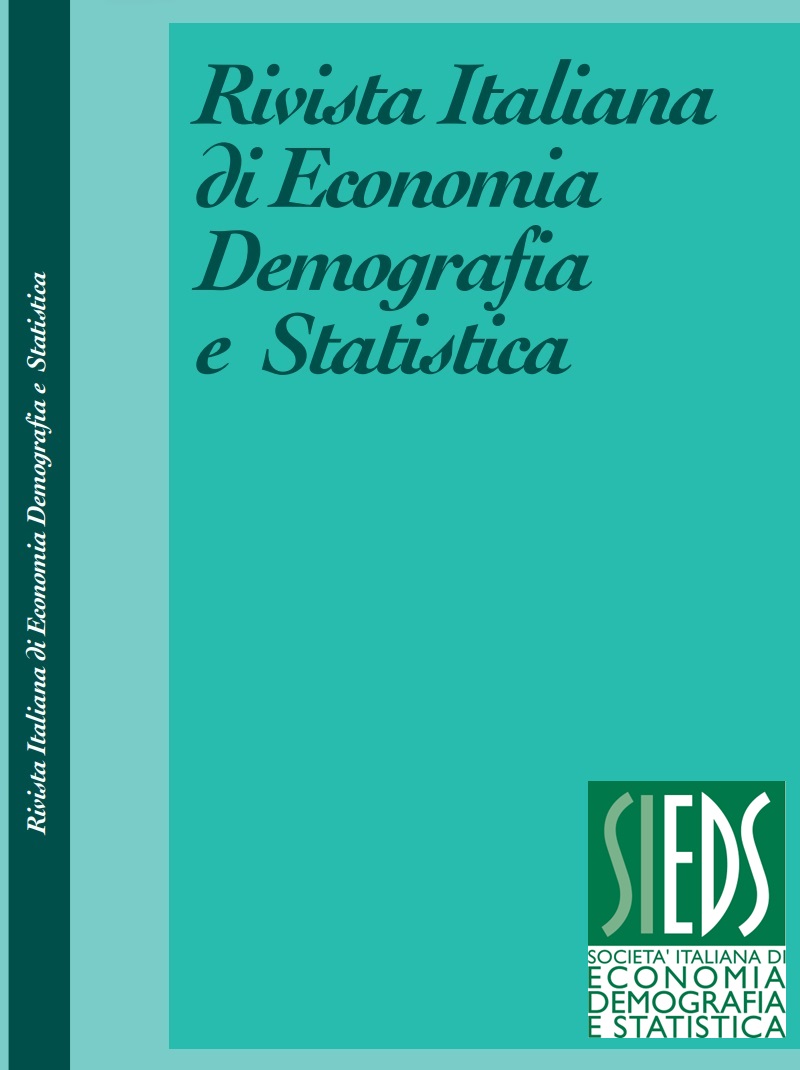Labour Market Participation of Second-Generation Youth In Italy
DOI:
https://doi.org/10.71014/sieds.v78i3.289Keywords:
second-generations, labour market, participation, youth, ItalyAbstract
As second-generation youth are just beginning to enter the labour market in Italy, there is a significant knowledge gap on their labour market outcomes. As regards participation, an important dimension of economic and social integration of youth, second generations might be affected by the same widespread discouragement experienced by youth with no migratory background, even worsened by a more difficult access to employment and/or discrimination. Conversely, they could develop a strong labour market attachment due to ethnic disadvantage in accessing higher education and/or different expectations and aspirations.
Using the “decimal generations” framework to define second generations, the article explores the differences in the composition of youth with and with no migratory background by labour market status, focusing on being a student as a special condition of youth inactivity and on being active in the labour market.
The analysis builds on the ISTAT Labour Force Survey that since 2021 has released information on the country of birth of the respondent’s parents thus allowing the identification of second generations both in the strict, i.e. the country-born children to at least one foreign-born parent, and extended sense, i.e. the foreign-born who arrived in Italy as children, while previous studies have mainly used respondents’ citizenship. Multivariate models are run to control for socio-demographic composition effects and results show that country-born second generations have outcomes similar to those of the youth with no migratory background. In contrast, the 'in-between' generations -the foreign-born who migrated as children or young adolescents- are less likely to be students but are more likely to be active in the labour market than youth with no migratory background. The analysis then highlights a clear-cut difference between the country-born and the foreign-born children of immigrants.
References
ALBA, R., NEE, V. 1997. Rethinking Assimilation Theory for a New Era of Immigration, International Migration Review, Vol.31, No.4, pp. 826-874. DOI: https://doi.org/10.1177/019791839703100403
AMBROSINI, M., POZZI, S. 2018. Italiani ma non troppo? Lo stato dell’arte della ricerca sui figli degli immigrati in Italia. Genova: Centro studi Medí-Migrazioni nel mediterraneo.
BUONOMO, A., GABRIELLI, G., GATTI, R., STROZZA, S. 2023. Occupational Characteristics and Trajectories of Young Immigrants’ Descendants in Italy. Rivista Italiana di Economia Demografia e Statistica. Vol. LXXVII No.4
CHISWICK, B. R. 1977. Sons of Immigrants: Are They at an Earnings Disadvantage? American Economic Review, No.67, pp. 376-380
DEMARIE, M., MOLINA, S. 2004. Introduzione. Le seconde generazioni. Spunti per il dibattito Italiano. In AMBROSINI, M. AND MOLINA, S. (Eds.), Seconde generazioni. Un’introduzione al future dell’immigrazione in Italia. Edizioni Fondazione Giovanni Agnelli. IX-XXIII.
DROUHOT, L. G., NEE, V. 2019. Assimilation and the Second Generation in Europe and America: Blending and Segregating Social Dynamics Between Immigrants and Natives. Annual Review of Sociology, Vol.45, No.1, pp. 177–199. DOI: https://doi.org/10.1146/annurev-soc-073117-041335
EUROSTAT. 2024. EU Labour Force Survey - new methodology from 2021 onwards. Eurostat Statistics Explained. Retrieved October 26, 2024, from https://ec.europa.eu/eurostat/statistics-explained/index.php?title=EU_Labour_Force_Survey_-_new_methodology_from_2021_onwards
GABRIELLI, G., IMPICCIATORE, R. 2022. Breaking down the barriers: Educational paths, labour market outcomes and wellbeing of children of immigrants. Journal of Ethnic and Migration Studies, Vol.48, No.10, pp. 2305–2323. DOI: https://doi.org/10.1080/1369183X.2021.1935655
HEATH, A. F., ROTHON, C., KILPI, E. 2008. The Second Generation in Western Europe: Education, Unemployment, and Occupational Attainment. Annual Review of Sociology, Vol.34, No.1, pp. 211–235. DOI: https://doi.org/10.1146/annurev.soc.34.040507.134728
HEATH, A., CHEUNG, S. Y. 2007. Unequal Chances: Ethnic Minorities in Western Labour Markets. London: British Academy. DOI: https://doi.org/10.5871/bacad/9780197263860.001.0001
HERMANSEN, A. S. 2017. Age at Arrival and Life Chances Among Childhood Immigrants. Demography, Vol.54, No.1, pp. 201–229. DOI: https://doi.org/10.1007/s13524-016-0535-1
ISTAT. 2020. Identità e percorsi di integrazione delle seconde generazioni in Italia. Roma: Istat.
ISTAT. 2024. Rapporto annuale 2024: La situazione del Paese. Roma: Istat.
KING, R., LAZARIDIS, G., TSARDANIDĒS, C. G. 2000. Eldorado or fortress?: Migration in Southern Europe. St. Martin’s Press. DOI: https://doi.org/10.1057/9780333982525
MUÑOZ-COMET, J., ARCARONS, A. F. 2022. The occupational attainment and job security of immigrant children in Spain. Journal of Ethnic and Migration Studies, Vol.48, No.10, pp. 2396–2414. DOI: https://doi.org/10.1080/1369183X.2021.1935662
PARK, R. E. 1950. Race and culture. Free Press.
PICCITTO, G. 2023. The later, the better? The ethnic penalty on labor market achievement by migrant generation: evidence from Italy. Sociologia del lavoro, No.166, pp. 79–101. DOI: https://doi.org/10.3280/SL2023-166004
PORTES, A., RUMBAUT, R. G. 2001. Legacies: The story of the immigrant second generation. University of California Press.
PORTES, A., ZHOU, M. 1993. The New Second Generation: Segmented Assimilation and Its Variants. The ANNALS of the American Academy of Political and Social Science, No.530, pp.74–96. DOI: https://doi.org/10.1177/0002716293530001006
RUMBAUT, R. G. 1997. Assimilation and Its Discontents: Between Rhetoric and Reality. The International Migration Review, Vol.31, No.4, pp. 923–960. DOI: https://doi.org/10.1177/019791839703100406
RUMBAUT, R. G. 2004. Ages, Life Stages, and Generational Cohorts: Decomposing the Immigrant First and Second Generations in the United States. International Migration Review, Vol.38, No.3, pp. 1160–1205. DOI: https://doi.org/10.1111/j.1747-7379.2004.tb00232.x
SCHNEIDER, J. 2016. First/Second Generation Immigrants. NESET II ad hoc question IMIS, No. 4.
UNT, M., GEBEL, M., BERTOLINI, S., DELIYANNI-KOUIMTZI, V., HOFÄCKER, D. 2021. Social Exclusion of Youth in Europe: The Multifaceted Consequences of Labour Market Insecurity. Bristol: Bristol University Press. DOI: https://doi.org/10.56687/9781447358756
Downloads
Published
Issue
Section
License
Copyright (c) 2024 Ivana Fellini, Francesca Megna

This work is licensed under a Creative Commons Attribution 4.0 International License.



